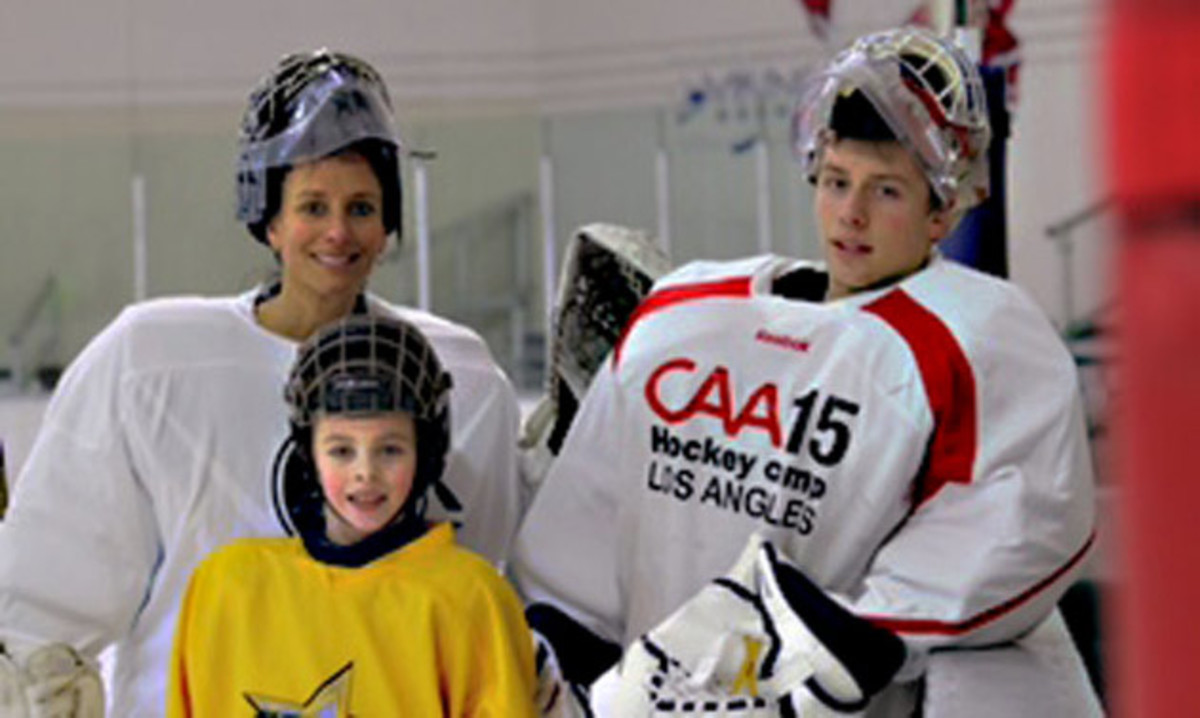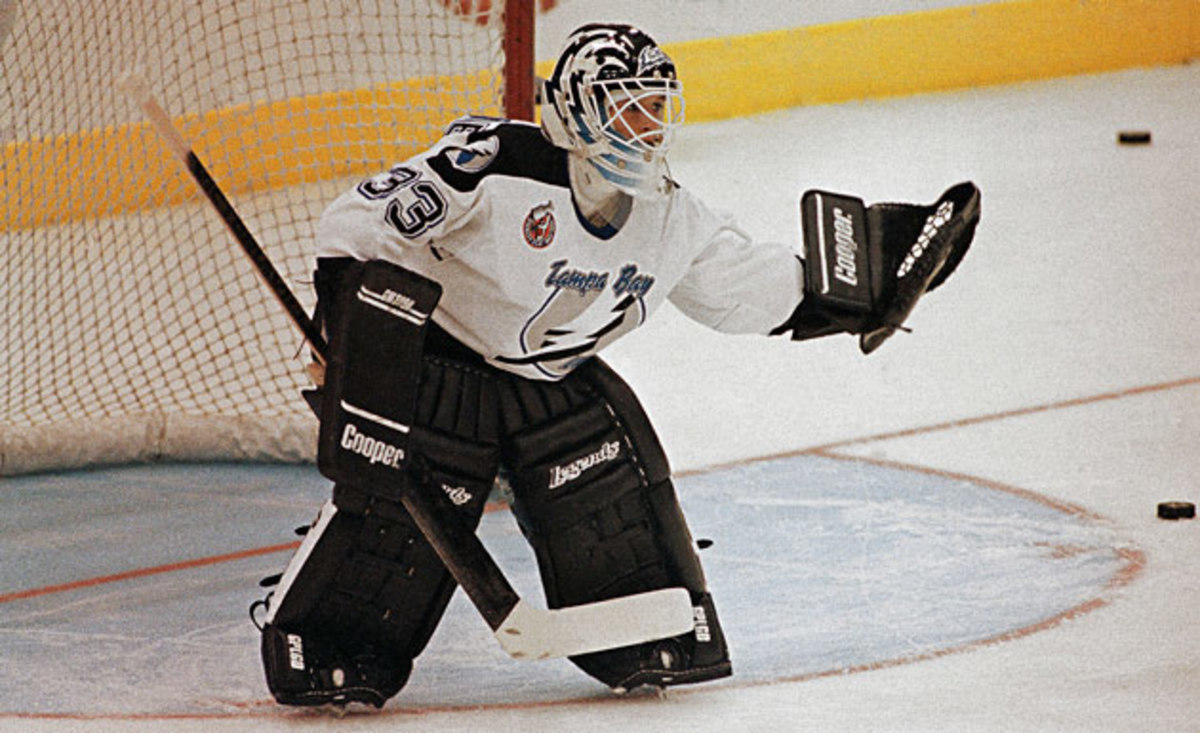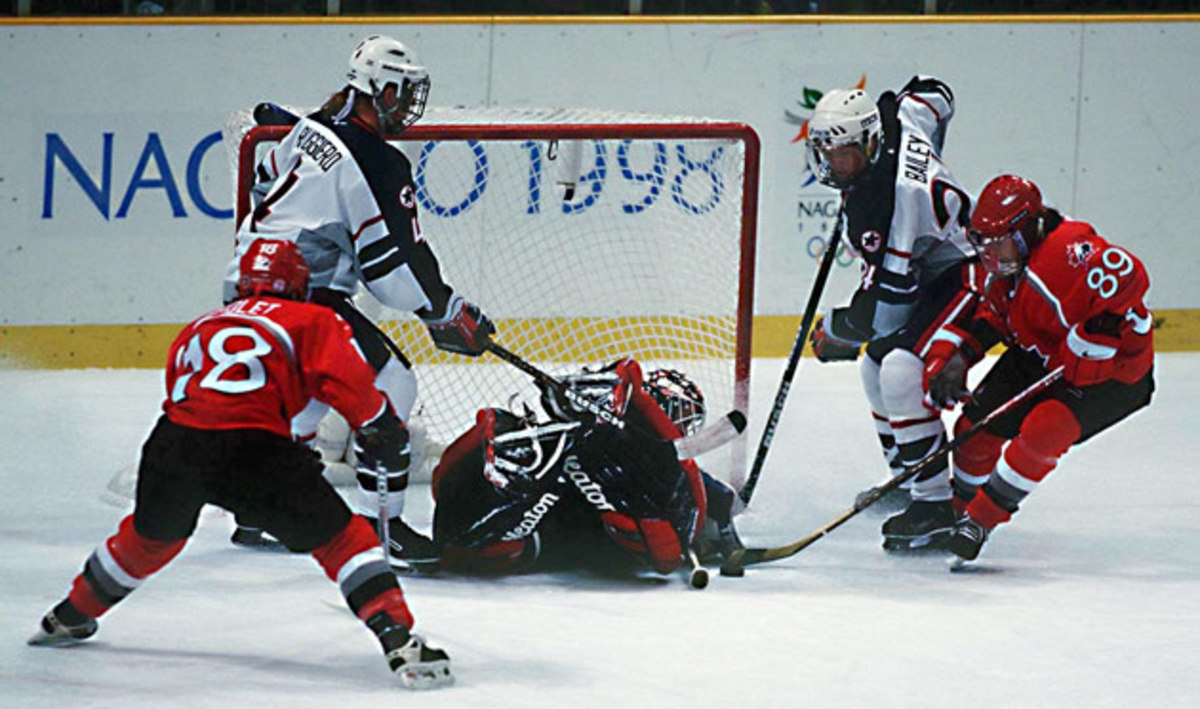Manon Rheaume, NHL's first female goalie, continues to inspire

Your teams. Your favorite writers. Wherever you want them. Personalize SI with our new App. Install on iOS (iOS or Android)
Manon Rheaume’s worst nightmare has come true. Her son is a goaltender. Just like she was.
She loves the position. Loved being at the center of it all, the game resting on her shoulders. But she hates that her son is a goalie. Even worse? He’s really good. Just like his mom.
Rheaume was working with Mission Hockey, an equipment company, when her son, Dylan, started to skate at age three. Mission made a cute little goalie gear set for kids. So she put one on him and watched him bumble around the ice. But when he started to gravitate towards the net, her fear began to kick in. She was used to being in control. Now? She has to watch idly from the sidelines as Dylan deals with the pressure of stopping pucks. “It’s the thing I hate the most,” she says. “Everybody looks at the goalie. If you have a bad goal, everyone remembers that.”
• Shannon Szabados breaking through barriers with SPHL’s Cottonmouths
When Rheaume became the first female goaltender in NHL history in 1992, she was as celebrated for her looks as her play. Her narrative was controlled by others; as were the dreams of those who wanted to be just like Manon. Now, at age 44, with a feature film based on her life on the way, she has control of her story, and is able to display it for the world. And the young girls who wanted to be like Manon are now taking their turn in the spotlight, thanks in large part to her.

Manon Rheaume started playing goalie at age five while growing up in Lac-Beauport, Quebec. There was no team for kids in her town, so her father, Pierre, built a rink and organized one. When no one wanted to play goalie, Manon seized the chance and quickly became good at it, setting out on her journey to history.
Unlike with boys, there was no established system even in hockey mad Quebec for girls to advance their hockey careers if they wanted to pursue them. With every new season came a new tryout with a boys team. With every new tryout came the snickering of parents. “No way my son is going to get bumped from that team for a girl,” they would say. Coaches soon followed—they told Manon's father to stop bringing her.
“A lot of people ask me, [how] did you make it that far, when everyone was saying no?’” Rheaume says on the phone from her home in Northville, Mich., a Detroit suburb. “A big part of it is my parents. My dad was not afraid to put me in a situation where he knew I’d be failing. He was never going to stop me from being in a situation where I may not make a team.”
• First-round picks show how NWHL GMs view their teams
Despite the resistance and obstacles, Rheaume just kept going, continuing to play until the major junior team Trois-Rivieres called on her after its number one goaltender went down with an injury in November 1991. No, surrendering three goals in 17 minutes wasn’t an ideal debut. It was, instead, groundbreaking. Rheaume was the first woman to play in major junior. But it would have to be enough. She was 20 years old, studying to be a teacher and working summer jobs to make money. This was as good as it was going to get.
As it turned out, an NHL scout had noticed Rheaume’s play, sending a videotape of her Trois-Rivieres game to Phil Esposito, who was in the midst of starting up the expansion Tampa Bay Lightning. The scout did not tell Esposito that the goalie was a girl. Esposito was gobsmacked when he made the discovery.
While working a summer internship at the broadcast station RDS, Rheaume met the scout who thought so highly of her. She was running around the floor of the Forum trying to wrangle newly selected players for interviews when he told her, “Phil Esposito wants to talk to you.”
And so the groundbreaking goalie walked over to the Hall of Famer. He had a simple question:
How would you like to go to Tampa?
Esposito needed publicity for his new team, as he later admitted to the Tampa Tribune. But Rheaume knew this and still welcomed the opportunity. “After so many people [before] said no to me because I’m a girl, if this time someone says yes to me because I’m a girl, I’m going to take that opportunity,” she says.
The publicity machine that suddenly surrounded Rheaume's appearance worked against her. There was an offer from Playboy to pose nude, which she declined. And an interview with David Letterman, in which he appeared more interested in her pretty face and funny-sounding name. Sportswriters asked about her nails. There was little focus on her performance on the ice and coach Terry Crisp remained aloof. But Rheaume acquitted herself well.
• Trip to North Pole a true Canadian moment for Lacasse, Ouellette
"I think she did an excellent job; she did a much better job than any of the males would have under that microscope," Lightning goalie Wendell Young later told NHL.com. "She was hitting a new frontier in hockey, representing women in hockey and she put it all on her shoulders. With the scope of the amount of people who were watching, we would have never had that media frenzy if she wasn't there. I talked to her quite a bit about it, but every day you just saw this stack of demands for her. There was just an enormous amount of people clamoring for her. But she handled it unbelievably. She came in as a pro and treated everything that way. She treated it as a job; she came to camp like anybody else trying to get a position. But she had extra stuff to deal with, and she did it well. But once she got on the ice, it was all about hockey."
On September 23, 1992, Rheaume became the first woman to play in a major professional hockey game.

At the same time that Manon Rheaume was stepping onto the ice in Tampa, five-year-old Dani Rylan was starting to play hockey. She lived in Tampa and her father worked in marketing for the Lightning. As a tyke, Dani skated with the Junior Lightning. She had a signed puck from Rheaume. And just as Manon had become the NHL's first female goalie, Dani wanted to grow up to be its first defensewoman and also play for the Lightning.
After her playing career came to an end when she graduated from Northeastern University, Rylan opened a coffee shop, Rise and Grind, in New York City's East Harlem. At the age of 28 and with the help of investors plus a long list of hockey contacts, she decided to extend the legacy of her hero by starting the National Women’s Hockey League. Established in 2015, the NWHL just finished its inaugural season, with four teams in New York, Connecticut and Massachusetts. As an added bonus, Rylan also got the chance to shoot a few pucks at her hero.
• Marie-Philip Poulin, Leslie Oles excel as CWHL neo-rookies
Rylan will be the first to tell you that Rheaume belongs on a Mount Rushmore of female hockey players who paved the way for the NWHL to exist. Without Rheaume, without Cammi Granato and Angela Ruggiero, there would be no NWHL. There would be no dreams of expansion; no more opportunities for the 180 Division I women who graduate from hockey programs each year if Rheaume had not attended training camp with Lightning and taken the ice for a preseason game, the franchise's first at home, against the St. Louis, her heart beating so fast that she remembers it feeling like it was bursting through her chest protector. She played one period, faced nine shots, allowed two goals and headed for the bench with the game tied 2–2.
“There are girls who can dream about being professional hockey players like their brothers,” says Rylan. “That’s a realistic goal.”
But Rylan knows about the struggle, too. It took 22 years from Rheaume’s last save for another woman to get paid to play hockey. She knows the ridicule that the Lightning and Rheaume faced. She knows what Sports Illustrated magazine had to say on September 28, 1992: “Is her playing goal in Tampa a breakthrough in women’s sports?” E.M. Swift wrote. “Sorry. I call it manipulative and sexist, a desperate attempt to sell a bad hockey team to an uninitiated Southern city ... It doesn’t hurt the publicity seeking Lightning that Rheaume is pretty and that she was reportedly was offered, and turned down, $50,000 from Playboy for a photo layout.”
Rylan also knows what she told herself as a kid. If Manon can do it, I can too. So when she’s read an excerpt from that same piece, she smiles.
• Small victories helping Blades’ Lacasse star amid trying season
“The tryout that will truly herald a breakthrough in women’s sports,” Swift wrote, “and merit our attention and applause is the day someone like Manon Rheaume is able to seek a spot on a Tampa Bay entry in the National Women’s Hockey League. Now that’s a goal worth tending.”
“I got goosebumps hearing that,” Rylan said, Rhéaume's dream now, finally, available to the masses.

After her brief stint with Tampa Bay (she saw no more game action), Rhéaume continued on her hockey journey. She played in the IHL and posted a 3-0-0 record with 3.64 goals-against average while with Nashville of the ECHL during the 1993-94 season. In 1997, her autobiography Manon: Alone in Front of the Net was published. She won a silver medal with Canada's women’s team at the 1998 Winter Olympics Nagano (photo above), contributing two shutouts.
Despite her success, Rheaume made a decision soon after her son was born. She was at a national team camp, and after a stressful experience breastfeeding between practices, she realized she was done. Hockey would go to the side. Motherhood would come first.
“That became my priority,” she says, pointing to the example her own mother and father set decades earlier. “My parents were amazing with [my brothers and I]. They always put us first. I didn’t have problems retiring.”
Rheaume went on to work with Mission hockey as a marketer, helping to make and sell girls hockey equipment. She also started the Manon Rheaume Foundation to help girls realize their dreams. But now she is a hockey mom, one whose goal remains inspiring others to dream big.
• Amanda Kessel signs with NWHL with an eye toward Olympics
Angie Bullaro, an actress who has starred in Gut and The Networker, also hopes to inspire others to dream big. With her production company Lazy Kitty, she wanted to make a movie about a strong female lead. After looking around, she remembered a story about a woman playing goalie in the NHL during the 1990s. When Rheaume and Bullaro finally met, they both stopped in their tracks. You look just like me! The movie about Rheaume’s life was on.
Bullaro is hyper-energetic and speaks in ALL CAPS. She believes deeply in the inspirational power of Rheaume’s story. She wants the movie, to be titled Between the Pipes and released in 2017, to be the A League of Their Own for the 21st Century. That it has taken this long for Manon’s story to be told baffles her.
“They’re making one about John Scott!” Bullaro screams, referring to the lumbering enforcer who became the unlikely 2016 NHL All-Star Game MVP after making the roster via fan vote. “I was like ‘really?’ Come on. It’s a cool story, but let’s be real here. Her story is so amazing. The whole thing was just incredible.”
Rheaume admits that seeing a movie about herself would be surreal. But she’s on board, and will help out when she can, because she wants to move people. Bullaro wants that too. But she also wants to make Rheaume a household name again.
“They should know her story!” Bullaro says, excitedly. “They should know who Manon Rheaume is. I can’t tell you how many hockey players had no idea who she is. We need to change that. We know all the other big names, the first one to do this, to do that, but we don’t know her. We want to bring it back out of the shadows.”
Manon Rheaume’s legacy lies in her descendants, both real and inspired.
It lies with Jenny Scrivens, who stopped playing before her senior year at Cornell in 2009 because she needed to find something to do in the real world. But after her eight-game stint with the NWHL’s New York Riveters last season, Scrivens is now able to finish the sport on her terms.
It lies with Kelli Stack, who along with Scrivens played the pee-wee All Star team that Rheaume coached at the annual International Hockey Tournament in Quebec, the first all-girls team to play with the boys there. No player made more money playing women’s hockey than the $25,000 Stack took home last season.
• Hilary Knight loving life as an NWHL star
It lies with a boy who looked cute as a three-year-old in goalie gear. The kid who didn’t know his mom was famous. And when he found out she was, didn’t realize that she was the only mom to play in the NHL.
Manon Rheaume is still just mom to 17-year-old Dylan St. Cyr. Even if she’s a mom who played the same position he does, and who’s more nervous about it than him.
Dylan will attend the University of Michigan in the fall of 2017. And Rheaume will sit in the stands of Yost arena, a maize-and-blue sweater draped on her shoulders. She will live and die with each shot on her son's net, her dream now a nightmare of the best kind.
